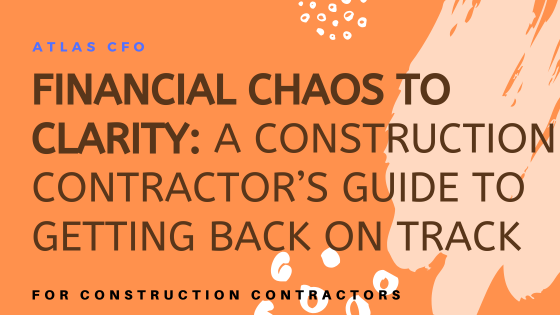If your construction company’s financials feel like a mess—missing reports, questionable numbers, or gut feelings that don’t match your bottom line—you’re not alone.
We’ve worked with hundreds of contractors, and almost every single one has said the same thing at some point:
“I’m making money… I think. But my books don’t really show it.”
Whether you’ve outgrown your current systems, lost track of project profitability, or are just overwhelmed trying to piece everything together—there’s good news:
You can absolutely get back on track.
This guide will walk you through the signs of financial chaos, what causes it, and—most importantly—how to move toward clarity, confidence, and control.
Signs You’re Stuck in Financial Chaos
- You can’t trust your monthly financial reports.
- Your CPA, banker, or bonding agent is asking for “better” reports.
- You’re constantly surprised by how little money is in the bank.
- Your WIP doesn’t tie to your financials—or you don’t have a WIP at all.
- You rely on your gut more than your data.
- You’re not sure where to even begin.
If any of these sound familiar, it’s not a character flaw—it’s a system problem.
How Contractors Get Here (It’s More Common Than You Think)
There are a few common patterns we see that lead to this stage:
- You Grew Without the Systems Your business took off (congrats!), but your financial system didn’t keep up. What worked at $2M doesn’t work at $10M.
- You Hired Help, But Not Expertise Maybe you have a bookkeeper or controller, but they weren’t trained in construction accounting. So the numbers are close… but not decision-ready.
- You’re on the Wrong Software QuickBooks might have worked early on, but it doesn’t support percent-complete accounting or job-level financial visibility.
- You’ve Been Too Busy to Slow Down You’ve got jobs to run, teams to manage, and fires to put out. Financial chaos builds quietly—and then it hits loud.
Step 1: Acknowledge It and Pick a Starting Point
Getting back on track doesn’t require you to fix everything at once. It starts with one question:
“What’s the one thing I know is wrong or missing?”
Maybe it’s AR that’s never reconciled. Maybe it’s the fact that your WIP doesn’t update monthly. Or maybe you don’t even get financials until taxes are due.
Pick that starting point. Then move forward step-by-step.
Step 2: Clean Up the Foundation
Most construction financial chaos is rooted in a few core areas:
- Balance Sheet doesn’t reconcile
- WIP is inaccurate or non-existent
- Job costs don’t match actual spending
- Owner draws and personal expenses are mixed in
- Revenue isn’t recognized correctly (especially for longer projects)
Start cleaning from the bottom up:
- Reconcile every bank, credit card, and loan account
- Tie AR and AP to detailed reports
- Build or fix your WIP schedule
- Create a financial close checklist so it doesn’t fall apart again
Step 3: Build Reporting You Can Trust
You need:
- Monthly financial statements (Balance Sheet + Income Statement)
- An accurate, timely WIP report
- Job-level tracking of actual vs. estimated costs
- Clear cash flow visibility
- Optional: Projections and forward-looking views
These aren’t just for your CPA or bonding agent. They’re for YOU. Because once you can see clearly, you can lead clearly.
Step 4: Train Your Team (and Yourself)
If you want clarity to last, you’ll need buy-in across your team:
- Project Managers understanding labor burden and job costing
- Bookkeepers trained in percent-complete revenue recognition
- Owners (yes, you!) reading reports monthly—not just at tax time
We often see chaos return when only one person understands the system. Shared knowledge = sustainable clarity.
You Don’t Have to Do It Alone
Getting from chaos to clarity isn’t a DIY job for every contractor. That’s why we built the Financial Systems Rebuild—a 3-month intensive where we:
- Clean up and rebuild your financials
- Train your team along the way
- Set up a reporting system that works
- Create a process you can sustain (not just a one-time fix)
Whether you need a full rebuild or just a second set of eyes, we’re here to help.
Final Thought
You didn’t get into this business to become a financial analyst.
But understanding your numbers—even at a high level—is one of the most powerful things you can do for your company’s future.
Clarity isn’t just possible—it’s the next step in your growth.

